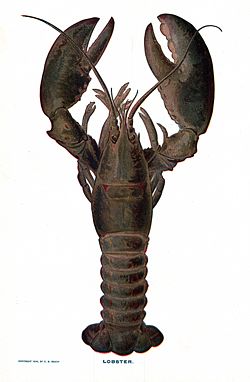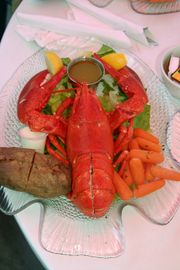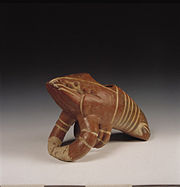|
Lobsters. What is it, were does it come from, and why is it considered a great delicacyThough several different groups of crustaceans are known as "lobsters," the ones with the claws are most often associated with the name. Clawed crustaceans are not closely related with spiny crustaceans or slipper crustaceans, which have no claws (chelae), or squat crustaceans. The closest relatives of clawed crustaceans are the reef crustaceans Enoplometopus and the three families of freshwater crayfish. Now that we have that paragraph over with , lets call them "lobsters". Biology They are invertebrates and have a tough protective exoskeleton. Like most arthropods, lobsters must molt in order to grow, leaving them vulnerable during this time. During the molting process, several species may experience a change in color.
They typically eat live food, consisting of fish, mollusks, other crustaceans, worms, and some plant life. Occasionally, they will scavenge if necessary, and may resort to cannibalism in captivity; however, this has not been observed in the wild. Thier skin has been found before in their stomachs, although this is because they will eat their shed skin after molting. They grow throughout their lives and it is not unusual for a them to live for more than 100 years. They can thus reach impressive sizes. According to the Guinness World Records, the largest one was caught in Nova Scotia, Canada and weighed 20.14 kg (44.4 lb). Being arthropods, they are largely bilaterally symmetrical; clawed ones often possess unequal, specialized claws, like the king crab. A freshly caught one will have a claw that is full and fleshy, not atrophied. The anatomy of the them includes the cephalothorax which is the head fused with the thorax, both of which are covered by the carapace, of chitinous composition, and the abdomen. Their head consists of antennae, antennules, mandibles, the first and second maxillae, and the first, second, and third maxillipeds. Because a they live in a murky environment at the bottom of the ocean, its vision is poor and it mostly uses its antennae as sensors. Studies have shown that their eye is formed with a reflective structure atop a convex retina. In contrast, most complex eyes use refractive ray concentrators (lenses) and a concave retina. The abdomen includes swimmerets and its tail is composed of uropods and the telson. In general, they move slowly by walking on the bottom of the sea floor. However, when they are in danger and need to flee, they swim backwards quickly by curling and uncurling their abdomen. A speed of 5 meters per second has been recorded.
They are a valued foodstuff; well-known recipes include Lobster Newberg and Lobster Thermidor. They are best eaten fresh, and they are normally purchased live. They are usually shipped and sold with their claws banded to prevent them from injuring each other or the purchaser. They cannot open and close the claws when they are banded, which causes the claws to begin to atrophy inside the shell. Very fresh ones will not show this, and the claws will be full. Many restaurants that serve them keep a tank of the live creatures, often allowing patrons to pick their own.
When boiling a them, the general rule of thumb is to simmer the lobster for 7 minutes for the first pound and 3 minutes for each additional pound. The shell makes eating them a slow process for the unskilled or timid, who may require a number of implements including nutcrackers, a small fork, and a plastic bib. It is possible to shell them by hand if one is careful to avoid the sharp points. The tail can be snapped open by first squeezing its sides inward, and then grabbing the edges of the shell, placing the thumbs on the dorsal side and pulling the sides apart. The claws usually open by hyper-extending the "thumb" and then pulling it out. Sometimes the claws can then be cracked by simply squeezing them. Otherwise, an ordinary fork is usually sufficient to snap open the side of the claw. Some restaurants will split the tail and crack the claws in the kitchen. This is done to simplify their diner's meals and in some cases as a decorative step. (Especially when they are to be served with a sauce poured over the tail.) The majority of the meat is in the tail and the two front claws, but smaller quantities can be found in the legs and torso. The larger they are the greater the proportion of meat in the small legs and body. They can be consumed simply, boiled or steamed, or used in a wide array of dishes and salads. It can be served as lobster soup or bisque or mixed with mayonnaise or salad dressing for rolls. The meat is often dipped in melted butter, resulting in a sweetened flavor. History The European wild one, among whom is the royal blue lobster of Audresselles, is more expensive and rare than the American one but was always appreciated chiefly among the royal and aristocratic families of France and the Netherlands. Such scenes were depicted in Dutch paintings of the sixteenth and seventeenth centuries. In North America prior to the 20th century, the local ones were not a popular food. In the Maritimes, eating them was considered a mark of poverty. In some parts of the Maritime provinces of Canada, they were used as a fertilizer for farmers' fields, and a great deal of them were fed to slaves or the lower members of society. Outside of the rural outports they were sold canned, losing much of its flavour, which can be disguised if it is dipped in drawn butter. The reputation changed with the development of the modern transportation industry that allowed live ones to be shipped from the outports to large urban centres. Fresh supply quickly became a luxury food and a tourist attraction for the Maritime provinces and Maine and an export to Europe and Japan where it is especially expensive. The expense of eating lobster has led to supermarkets selling "faux lobster"; (which is clearly labeled as such), and it is made from fish (often pollock or other whitefish) that has been altered to look and taste similar to lobster. A few restaurants have gone so far as to sell "langostino lobster". Langostino translates into prawn, however the actual animal is, (more likely than not), a crab. Maine fishermen are upset that restaurants are passing off the fake as though it is an actual lobster, (the spiny lobster is also called langouste). It is doubtful that the customers would be very happy to find out they are paying more for what is probably nothing more than a fancy-named crab. Rubio's Fresh Mexican Grill sold a "Lobster Burrito" which was made from squat lobster, another shellfish which is also very similar to the crab. Catching The usual method of catching lobsters has been to use baited, one-way traps located deep underwater with a coded marker buoy at the surface so that fishermen can find their cages and not pull up someone else's traps. Around the year 2000, due to overfishing and demand overwhelming supply, many countries began to try lobster farming, which is similar to fish farming. Capacity for pain and suffering The question of whether or not they can experience pain is unresolved. Because of the ambiguous nature of suffering, most people who contend that they do have this capacity approach the issue using 'argument by analogy' — that is, they hold that certain similarities between them' and humans' biology or behavior warrants an assumption that they can feel pain. In February 2005, a review of the literature by the Norwegian Scientific Committee for Food Safety tentatively concluded that "it is unlikely that [lobsters] can feel pain," though they note that "there is apparently a paucity of exact knowledge on sentience in crustaceans, and more research is needed." This conclusion is based on their simple nervous system. The report assumes that the violent reaction them to boiling water is a reflex to noxious stimuli. However, a Scottish review released in the same year reported that "scientific evidence ... strongly suggests that there is a potential for them to experience pain and suffering," primarily because they (and other decapod crustaceans) "have opioid receptors and respond to opioids (analgesics such as morphine) in a similar way to vertebrates," and because of similarities in lobsters' and vertebrates' stress systems and behavioral responses to pain. A 2007 study at Queen's University, Belfast, suggested that crustaceans do feel pain. Acetic acid was placed on the antennae of 144 prawns; the animals responded by rubbing the affected areas. Professor Robert Elwood, who headed the study, argues that sensing pain is crucial to the survival of all animals, because it encourages them to avoid damaging behaviors. Some scientists responded, saying the rubbing may reflect an attempt to clean the affected area. Opioids In vertebrates, endogenous opioids are neurochemicals that moderate pain by interacting with opiate receptors. Opioid peptides and opiate receptors occur naturally in crustaceans, and although "at present no certain conclusion can be drawn,"some have interpreted their presence as an indication that they may be able to experience pain. The aforementioned Scottish paper holds that lobsters' opioids may "mediate pain in the same way" as in vertebrates. Morphine, an analgesic, and naloxone, an opioid receptor antagonist, may affect a related species of crustacean (Chasmagnathus granulatus) in much the same way they affect vertebrates: injections of morphine into crabs produced a dose-dependent reduction of their defensive response to an electric shock. (However, the attenuated defensive response could originate from either the analgesic or sedative properties of morphine, or both.) These findings have been replicated for other invertebrate species, but similar data is not yet available for them. Animal rights issues The most common way of killing (cooking) them is by placing it, live, in boiling water. (This method is also used to kill crayfish and shrimp.) This is controversial because some people believe that they suffer. The practice is illegal in some places, such as in Reggio Emilia, Italy, where offenders face fines of up to €495. The Norwegian study states that they may be de-sensitized by placing it in a salt-solution 15 minutes before killing it. The quickest way to kill them may be to insert a knife into its head and cleave the head in two, thereby destroying two of the most important nerve clusters of they have. Some feel that this is more humane than placing them live into boiling water. Freezing them for 15 minutes to 2 hours before boiling may de-sensitize the lobster. Some stores will kill them upon purchase by microwaving it. Whether or not death occurs more quickly than when they are dropped in boiling water is not clear. There are, however, locations where the sale of dead ones to be eaten is illegal, including Massachusetts. In 2006, British inventor Simon Buckhaven invented the CrustaStun, which electrocutes lobsters with a 110 V electric shock, killing them in about five seconds. This ensures a quicker death for them. Seafood wholesalers in Britain already use a commercial version. A home version measuring about 46 cm width and depth came into the retail market in late 2006 for about GB£2000.
Lobsters in culture Moche lobster, 200 A.D., Larco Museum Collection Lima, Peru The Moche people of ancient Peru worshipped the sea and its animals. They were often depicted in their art.
Click Here to Return from lobster to Home Page Click to return from lobsters to recipes
Here's How to Get All Your Google AdWords Pay-Per-Clicks FREE!
|
 They live on rocky, sandy, or muddy bottoms from the shoreline to beyond the edge of the continental shelf. They generally live singly in crevices or in burrows under rocks.
They live on rocky, sandy, or muddy bottoms from the shoreline to beyond the edge of the continental shelf. They generally live singly in crevices or in burrows under rocks.
 If the they are to be boiled or steamed, most cooks place them live into the pot. If they are to be fried, grilled or baked it is best not to boil them before further cooking. Freezing them may toughen the meat.
If the they are to be boiled or steamed, most cooks place them live into the pot. If they are to be fried, grilled or baked it is best not to boil them before further cooking. Freezing them may toughen the meat.


